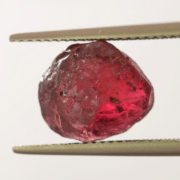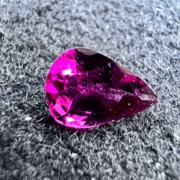Rhodolite stone – properties, virtues & benefits
Rhodolite stone is a variety of Pink-purple garnet, prized for its beauty and rarity. With its shimmering reflections and high hardness, it’s a popular option for fine jewelry. Discover the characteristics of this gemstone and how to add it to your jewelry collection.
CHARACTERISTICS OF RHODOLITE
- Chakra: Heart.
- Properties: Love, Compassion, Emotional Balance, Healing.
- Astrology: Venus.
- Zodiac: Aries, Taurus, ScorPio.
- Elements: Earth, Fire.
- Colors: Pink, Purple, Red.
- Hardness: 7-7.5 on the Mohs scale.
- Chemical Formula: Mg3Al2(SiO4)3.
- Associated god: None.
RHODOLITE – HIS HISTORY
Rhodolite stone has a long history dating back to antiquity, with rhodolite-adorned jewelry among the Egyptians, Greeks and Romans. Christians were also familiar with the stone, as it is mentioned in Genesis that Noah used a rhodolite lamp to Pilot his ark. Although similar to red garnet, rhodolite’s color is slightly lighter, earning it the nickname “Rhodolite garnet”. The stones are very popular in jewelry because of their hardness and violet-red hues, which can sometimes be mistaken for rubies. The most sought-after variety is one with purple-red tones.
In addition, there was a tradition that rhodolite was a powerful talisman that glowed in the dark and protected the wearer from evil sPirits. In 1966, several major events involving rhodolite took place. A 19th-century brooch sold at auction for $145,000 at Sotheby’s, organized by the Estate of Jacqueline Kennedy-Onassis. In addition, the largest stone ever discovered was found that year by an Australian student. It weighed several tonnes and had an estimated diameter of around 30 metres.
HRODOLITE STONE – ITS ORIGIN AND COMPOSITION
The name of the natural stone rhodolite derives from the Greek “rhodon”, meaning rose, and the Latin “rhodo”, also meaning Pink and referring to the predominant color of this stone. Rhodolite is a commercial name used for this stone, which is sometimes replaced by its synonym Umbalite, in reference to the stone’s main extraction area, the Umba Valley in Tanzania. Rhodolite is also found in many other countries, including Brazil, Madagascar, Zambia and Sri Lanka. Its chemical composition ((Mg,Fe)3Al2(SiO4)3) places it between pyrope and almandine, which classifies it in the garnet family of the PyralsPite series, with members such as spessartite and malaya garnet.
Rhodolite stone is available in shades of color ranging from Pink to violet, as well as all shades in between such as purple, due to the presence of iron in the almandine molecules. This stone is highly prized in jewelry stores for its color nuances and hardness, as it does not break easily. Rhodolite gems exceeding 10 carats are rare, and generally undergo no treatment other than polishing. Cabochon-cutting the stone creates a four- or six-pointed star pattern under a directional lamp, due to the presence of very minute acicular rutile inclusions.
Like amethyst, rhodolite has long been used in jewelry and is prized for its color nuances and hardness. However, it is sensitive to raPid and violent temperature variations, so it’s best not to plunge it into icy water on a very hot day to avoid cracking or shattering. Finally, rhodolite is easy to imitate or confuse with synthetic materials such as glass or zirconium oxide. It is therefore advisable to contact a professional dealer to guarantee its authenticity.

RHODOLITE STONE – VERTIES AND PROPERTIES
HRODOLITE ON THE PSYCHOLOGICAL LEVEL
Rhodolite stone is known to stimulate intuition, imagination and creativity, while develoPing a sense of good taste and aesthetics. It is associated with a certain nostalgia and the search for a peaceful, serene past, far removed from the hectic pace of the modern world, making it an ideal stone for recharging one’s batteries. In addition, rhodolite is beneficial for concentration and tasks that require meticulousness and precision, encouraging patience and allowing you to recharge your energy.
The stone’s Pink color has calming effects, helPing to keep calm in potentially conflictual situations and promoting the peaceful resolution of problems, both in professional and family life. Rhodolite can also boost self-confidence and openness to others, attracting the attention of those around the wearer and thus becoming an interesting professional asset. It facilitates encounters and the sharing of feelings within a couple, and also helps make financial projects a reality by attracting cash inflows, provided you have a clear vision of your desires and goals.
.
In short, rhodolite stone offers a variety of benefits, both physical and emotional, and can be a valuable asset for those seeking to develop creativity, patience, self-confidence and openness to others.
PHYSICAL RHODOLITE
Rhodolite stone is effective against various types of blood poisoning and can be a valuable aid in a withdrawal process, such as quitting smoking or drugs. It stimulates the will to undergo detoxification treatment. However, it is important to remain vigilant about possible contraindications, and it may be wise to combine it with other gems known for their soothing effects, such as cat’s eye tourmaline or aquamarine.
The effects of rhodolite stone may seem similar to those of other gemstones such as rubellite or magenta ruby, particularly when it comes to the soothing and restorative effects on everyday emotions. It’s important not to confuse rhodolite with stones such as corundum or tourmaline, as it does indeed belong to the garnet family.

RHODOLITE STONE – CLEAN AND RECHARGE
To clean and recharge your Rhodolite stone, here are a few simple steps:
Cleaning:
- Soak your stone in salt water for a few hours to purify it of accumulated negative energies.
- Use a soft brush and water to gently clean the stone’s surface, taking care not to damage it.
- Wipe the stone with a soft, clean cloth to dry.
Loading:
- Place your Rhodolite stone in direct sunlight for a few hours to recharge it with solar energy.
- You can also place the stone in an amethyst or quartz geode to recharge it with telluric energy.
- If you practice meditation, you can hold the stone in your hands and visualize positive energy entering the stone while expelling negative energies.
By following these simple steps, you can cleanse and recharge your Rhodolite stone to keep it energetically pure and vibrant.
WHERE DOES THE NAME RHODOLITE COME FROM?
The name “Rhodolite” is derived from two Greek words, “rhodon” meaning rose, and “lithos” meaning stone. Rhodolite is so called for its characteristic Pink color, although it can also have hues of purple and red. The stone was first described in 1882 in North Carolina, USA, and identified as a variety of garnet. Rhodolite is a relatively rare gemstone, making it a popular option for high-quality jewelry.
WHICH CHAKRA DOES RHODOLITE ACT ON?
Rhodolite is associated primarily with the Heart Chakra. It is considered a stone of love, compassion and emotional balance, which can help heal emotional wounds and open the heart to positive emotions such as love and joy. Working on the Heart Chakra, Rhodolite can help boost self-confidence and promote emotional growth, as well as improve interpersonal relationships and empathy.
WHICH ASTROLOGICAL SIGN IS ASSOCIATED WITH RHODOLITE?
Rhodolite is associated with several astrological signs, including Aries, Taurus and ScorPio. In general, this stone is considered beneficial for people born under these signs, but it can also be used by others who wish to benefit from its energetic properties. Rhodolite is also associated with the planet Venus, which is the planet of love and harmony, reinforcing its connection with emotions and interpersonal relationships.
RHODOLITE STONE SUMMARY
Rhodolite stone is a variety of garnet, a mineral in the silicate family. It is distinguished by its Pink to purplish-red color, which results from the presence of elements such as manganese, iron and chromium in its composition. Rhodolite is considered a fine stone and is used in jewelry to create rings, necklaces and other jewelry. It is also used in lithotherapy for its soothing and creative energy-stimulating properties. Rhodolite is often mined in Sri Lanka, Tanzania and Brazil.



